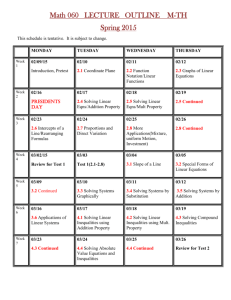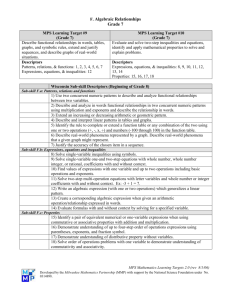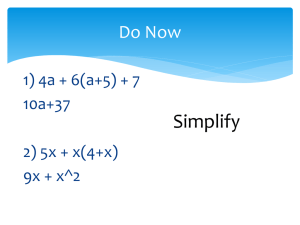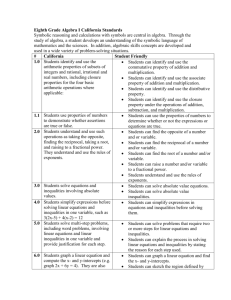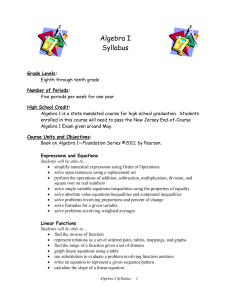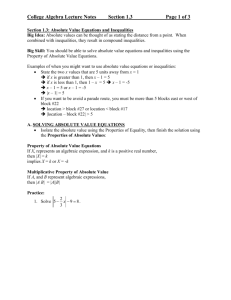Grade 8 - DepEd Naga City
advertisement
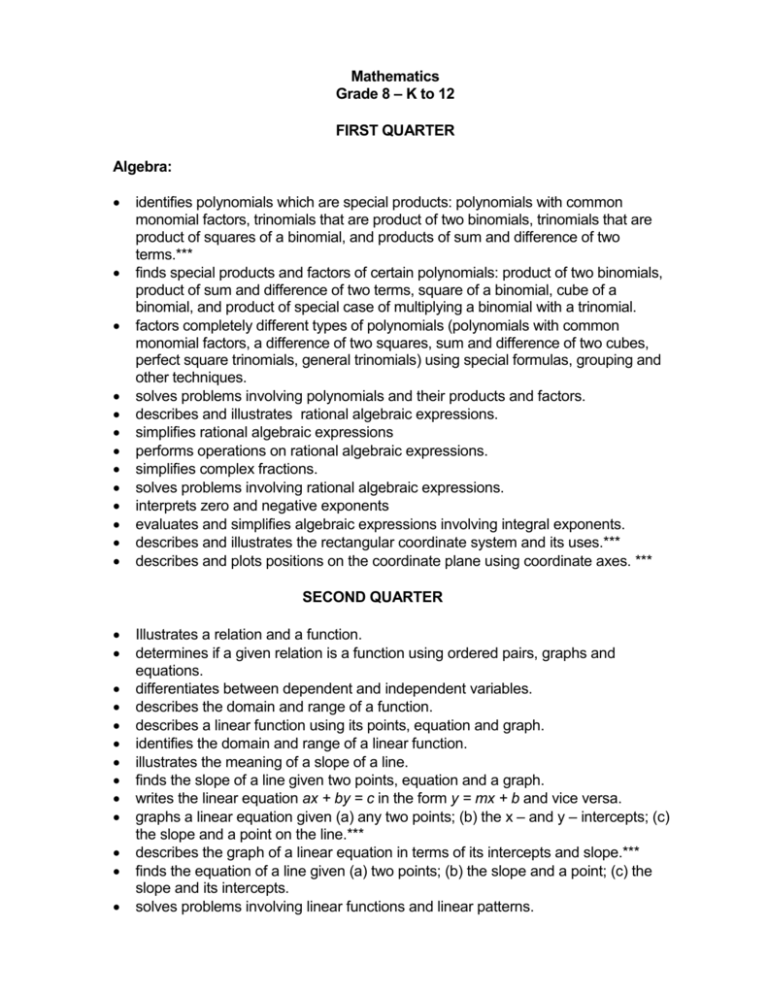
Mathematics Grade 8 – K to 12 FIRST QUARTER Algebra: identifies polynomials which are special products: polynomials with common monomial factors, trinomials that are product of two binomials, trinomials that are product of squares of a binomial, and products of sum and difference of two terms.*** finds special products and factors of certain polynomials: product of two binomials, product of sum and difference of two terms, square of a binomial, cube of a binomial, and product of special case of multiplying a binomial with a trinomial. factors completely different types of polynomials (polynomials with common monomial factors, a difference of two squares, sum and difference of two cubes, perfect square trinomials, general trinomials) using special formulas, grouping and other techniques. solves problems involving polynomials and their products and factors. describes and illustrates rational algebraic expressions. simplifies rational algebraic expressions performs operations on rational algebraic expressions. simplifies complex fractions. solves problems involving rational algebraic expressions. interprets zero and negative exponents evaluates and simplifies algebraic expressions involving integral exponents. describes and illustrates the rectangular coordinate system and its uses.*** describes and plots positions on the coordinate plane using coordinate axes. *** SECOND QUARTER Illustrates a relation and a function. determines if a given relation is a function using ordered pairs, graphs and equations. differentiates between dependent and independent variables. describes the domain and range of a function. describes a linear function using its points, equation and graph. identifies the domain and range of a linear function. illustrates the meaning of a slope of a line. finds the slope of a line given two points, equation and a graph. writes the linear equation ax + by = c in the form y = mx + b and vice versa. graphs a linear equation given (a) any two points; (b) the x – and y – intercepts; (c) the slope and a point on the line.*** describes the graph of a linear equation in terms of its intercepts and slope.*** finds the equation of a line given (a) two points; (b) the slope and a point; (c) the slope and its intercepts. solves problems involving linear functions and linear patterns. differentiates between mathematical expressions and mathematical equations. differentiates between mathematical equations and inequalities. illustrates linear inequalities in two variables. graphs linear inequalities in two variables on the coordinate plane. describes systems of linear equations and inequalities using practical situations and mathematical expressions. identifies which given systems of linear equations have graphs that are parallel, intersect and coincide. graphs systems of linear equations in two variables.*** solves systems of linear equations by (a) graphing; (b) elimination; (c) substitution.*** graphs system of linear inequalities in two variables.*** solves a system of linear inequalities in two variables by graphing.*** solves problems involving systems of linear equations and inequalities in two variables. THIRD QUARTER Geometry identifies the hypothesis and conclusions of if-then and other types of statements. formulates the inverse, converse and contrapositive of an implication. distinguishes between inductive and deductive reasoning. provides formal arguments that explain results of a phenomenon or a situation. writes formal arguments as a series of statements that make up a proof (both direct and indirect). illustrates the undefined terms in geometry. explains the need for defined terms previously introduced. differentiates between postulate and theory and give the importance of each. illustrate triangle congruence.*** states and illustrates the SAS, ASA and SSS congruence postulates.*** applies the postulates and theorems on triangle congruence to prove statements on congruence, including right triangles. applies triangle congruence to geometric constructions to perpendicular and angle bisector. states and illustrates the theorems on triangle inequalities, e.g. exterior angle inequality theorem, triangle inequality theorem, hinge theorem.*** applies theorems on triangle inequalities to: (a) determine possible measures for the angles and sides of triangles, and (b) justify claims about the unequal relationships between side and angle measures. applies the theorems on triangle inequalities to prove results involving triangle inequalities. illustrates parallel and perpendicular lines.*** illustrates and proves properties of parallel lines cut by a transversal.*** names the different kinds of quadrilaterals and identify those that are parallelograms. determines the conditions that make a quadrilateral a parallelogram, determines and proves the conditions under which lines and segments are parallel or perpendicular. uses properties to find measures of angles, sides, and other quantities involving parallelograms. FOURTH QUARTER Statistics and Probability: finds the mean, median and mode of statistical data describes and illustrates the mean, median and mode of ungrouped and grouped data. discusses the meaning of variability. calculates the different measures of variability of a given set of data: (a) range; (b) average deviation; (c) variance; (d) standard deviation.*** describes a set of data using measures of central tendency and measures of variability. describes an experiment, outcome, sample space and event.*** explains and interprets the probability of an event. differentiates between an experimental probability and a theoretical probability. counts the number of occurrences of an outcome in an experiment and organize them using a table, tree diagram, systematic listing and the fundamental counting principle.*** solves simple problems involving probabilities of events.


